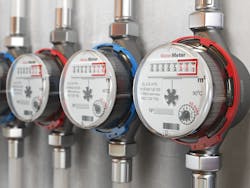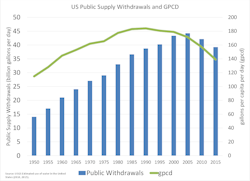Efficient Water Management’s Quiet Hero – the Water Meter
By Peter Mayer, P.E., Principal, Water Demand Management, Boulder, Colorado
Urban water efficiency programs and policies, implemented over the past 25 years, have resulted in lower per capita water use across the US, extending water supplies and reducing infrastructure costs. The United States Geological Survey (USGS) water use statistics have documented dramatic reductions in municipal water withdrawals over the past 15 years. These important changes in water demand were made possible by a humble and somewhat mundane measurement device – the water meter; this singular device, in conjunction with policies that require all water customers pay for what they use, is the catalyst for recent reductions in water use. The water meter is the quiet, but essential hero of urban water management.
Humans have managed water as a limited resource to be carefully and equitably apportioned and paid for since the beginning of public supply. Precise water apportionment and measurement procedures have been central to the provision of public water supply for more than 2,000 years as documented by the brilliant Roman engineer Frontinus. The AWWA M6 Manual, Water Meters – Selection, Testing, and Maintenance (5th ed.) notes that it, “took thousands of years for the science of water supply and distribution to reach its present state” (AWWA 2012).
The “present state” almost always includes a water meter at every service connection which is used to bill the customer for the volume of water used. The fact that water is accurately measured in a timely fashion by the water utility engenders consumer confidence and enables reliable revenue collection, a win-win situation. Meter accuracy and reliability has enabled water utilities to implement more effective water rate structures where the price of water increases as usage increases, thus incentivizing efficiency.
Ensuring each water meter is right-sized represents an on-going challenge in the water industry. Properly sized water meters allow for full and accurate revenue recovery for the utility through its chosen rate structure. An accurately sized meter delivers satisfactory water service and pressure to end users and ensures customers only pay for the water they use. Inaccurately sized water meters, either too big or too small, can create financial and maintenance problems.
Modern fixtures like toilets and faucets have gotten substantially more efficient due to state plumbing codes and federal policy. This has changed water usage patterns in buildings, reducing flows overall as well as the frequency and magnitude of peak flows. New research coming in 2019 from the Water Research Foundation on water demands in modern buildings will help re-evaluate meter sizing curves and offer recommendations and guidance for meter sizing and building plumbing.
The consumption data collected from water meters form fundamental water utility understanding of water usage and demand trends. These data are the basis for all utility water planning. Effective utility planning and management literally cannot be done with this information. It is difficult to overstate the importance of these data to the water utility.
From the customer perspective, the water meter is an under-utilized tool and it has been difficult for customers to get useful information from the meter. Traditionally water meters are “out of sight, out of mind,” located in a meter box or pit at the street or in the building basement. As droughts and water supply shortages were confronted in the late 20th century, some water utilities began encouraging their customers to find and read their water meter and use it for detecting leaks. Most water utilities, however, discouraged any potential meddling with the meter. In the past when water was cheaper and more plentiful, most customers had little interest or access to the meter.
The potential is significant, but the utility investment is substantial so it will likely take 10 to 20 years to complete this transition as water utilities slowly modernize metering systems.
Recent years have seen a revolution in meter communications and meter reading technology. Manual meter reading will eventually be a thing of the past, replaced by wireless transmission of meter reading data. Instead of once a month, modern water meters will be read once per hour (or even more frequently). While monthly consumption will still be used for billing purposes, hourly consumption data can reveal leakage, and hence, reduce water damage to building and water waste.
The on-going advances in utility metering communications will enable end users to finally take full advantage of water meter information for more effectively managing irrigation, eliminating waste, identifying abnormal usage, and lowering water bills through reduced consumption. The potential is significant, but the utility investment is substantial so it will likely take 10 to 20 years to complete this transition as water utilities slowly modernize metering systems.
The value of metered consumption data is further enhanced by pairing water consumption with information such as the number of residents or customers, size and description of the landscape, water using fixtures and practices. These data enable the efficiency of water use to be quickly and effectively evaluated. This information becomes particularly important during drought, when supplies and demands must be managed carefully.
We all know the saying, “you can’t manage what you don’t measure,” and the truth is water has been managed for thousands of years using measurement devices of ever increasing complexity and accuracy. The Romans carefully managed the aqueduct supplies just as modern water utilities carefully manage surface and groundwater resources.
Over the past 25 years, for the first time in US history, per capita water use and total water withdrawals have measurably declined, saving billions of dollars in avoided infrastructure costs. The accurate measurement of water use has played a quiet but essential role in reducing urban water demand and helping manage our water resources to this new level of efficiency. As we confront the water supply challenges of the next 25 years, the trusty water meter will be right there to help manage through good and bad times with maximum efficiency and accuracy.
Peter Mayer is a professional engineer and expert in urban water management. He is vice chair of the American Water Works Association Customer Metering and Practices Committee. He is a four-time winner of the AWWA and American Society of Civil Engineers Journal “Best Paper” awards, and a regular contributor to the AWWA Journal.

